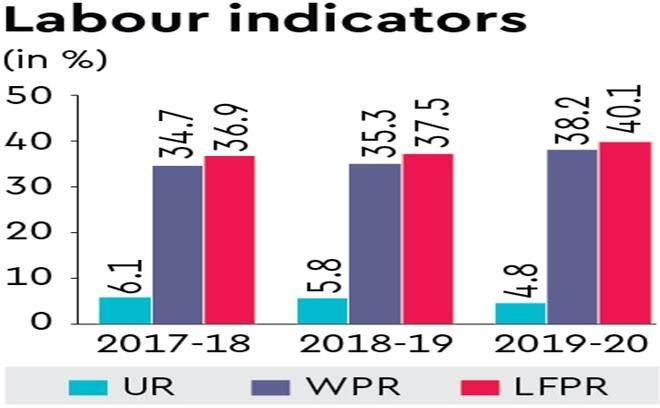Indian Economy
Periodic Labour Force Survey 2019-20
- 26 Jul 2021
- 6 min read
Why in News
Recently, the National Statistical Office (NSO) released the third annual report on Periodic Labour Force Survey (PLFS), conducted between July 2019 and June 2020.
- Labour indicators recorded an all-round improvement in 2019-20 compared with the previous two years i:e 2017-18 and 2018-19.
National Statistical Office
- It is the central statistical agency of the Government mandated under the Statistical Services Act 1980 under the Ministry of Statistics and Programme Implementation.
- It is responsible for the development of arrangements for providing statistical information services to meet the needs of the Government and other users for information on which to base policy, planning, monitoring and management decisions.
- The services include collecting, compiling and disseminating official statistical information.
- Other Reports & Indices by NSO:
Key Points
- Unemployment Rate:
- The unemployment rate fell to 4.8% in 2019-20. In 2018-19, it stood at 5.8% and 6.1% in 2017-18.
- Worker Population Rate:
- It improved to 38.2% in 2019-20 compared with 35.3% in 2018-19 and 34.7% in 2017-18.
- Labour Force Participation Ratio:
- It increased to 40.1% in 2019-20 from 37.5% and 36.9%, respectively, in the last two years. The higher the LFPR, the better.
- Gender Based Unemployment Rate:
- The data showed the jobless rate for both male and female fell to 5.1% and 4.2%, respectively, in 2019-20 from 6% and 5.2% in 2018-19.
- WPR and LFPR also comparatively improved during the year.
- The data showed the jobless rate for both male and female fell to 5.1% and 4.2%, respectively, in 2019-20 from 6% and 5.2% in 2018-19.
- Periodic Labour Force Survey:
- About:
- It is India’s first computer-based survey launched by the NSO in 2017.
- It has been constituted based on the recommendation of a committee headed by Amitabh Kundu.
- It essentially maps the state of employment in the country. In doing so, it collects data on several variables such as the level of unemployment, the types of employment and their respective shares, the wages earned from different types of jobs, the number of hours worked etc.
- Before PLFS, the National Sample Survey Office (NSSO)- previous name of NSO used to bring the data related to employment and unemployment based on its quinquennial (every 5 year) household socio-economic survey programme.
- Objective:
- To estimate the key employment and unemployment indicators (viz. WPR, LFPR, UR) in the short time interval of three months for the urban areas only in the Current Weekly Status (CWS).
- To estimate employment and unemployment indicators in both usual status and CWS in both rural and urban areas annually.
- About:
- Recent Government Initiatives to Tackle Unemployment:
- The Union government has come up with an economic stimulus package under Atmanirbhar Bharat Abhiyan to support the Indian economy and create jobs.
- Under the Pradhan Mantri Street Vendor's Atma Nirbhar Nidhi (PM SVANidhi), the Union Government is providing affordable loans to street vendors.
- In 2020 the government allocated an additional fund of Rs 40,000 crore for MGNREGA, as part of the stimulus package.
- The government is offering credit guarantees for Micro, Small and Medium Enterprises (MSMEs) which will help them in getting loans easily and boost their functioning.
- Pradhan Mantri Mudra Yojana to provide financial support to entrepreneurs to start small enterprises.
- Various other initiatives have also been taken by the government to support the economy which includes relaxation in Companies Act and Insolvency proceedings, reforms in agri- marketing etc.
- Government has also taken initiatives such as the New Code on Wages, 2019 to reduce gender-based discrimination in wages, recruitment and conditions of employment.
- State governments have also come up with the initiative to support their economy and increase jobs.
- Andhra Pradesh government’s ‘ReStart’ programme to support the MSME sector in the State.
- Jharkhand has launched three employment schemes to create wage employment for workers in rural areas.
- The Union government has come up with an economic stimulus package under Atmanirbhar Bharat Abhiyan to support the Indian economy and create jobs.
Key Terms
- Unemployment Rate (UR):
- It is defined as the percentage of persons unemployed among the persons in the labour force.
- Labour Force Participation Rate (LFPR):
- It is defined as the percentage of persons in the labour force (i.e. working or seeking or available for work) in the population.
- Worker Population Ratio (WPR):
- It is defined as the percentage of employed persons in the population.
- Activity Status:
- The activity status of a person is determined on the basis of the activities pursued by the person during the specified reference period.
- Usual Status: The activity status determined on the basis of the reference period of the last 365 days preceding the date of survey, it is known as the usual activity status of the person.
- Current Weekly Status (CWS): The activity status determined on the basis of a reference period of the last 7 days preceding the date of survey is known as the current weekly status (CWS) of the person.
- The activity status of a person is determined on the basis of the activities pursued by the person during the specified reference period.







